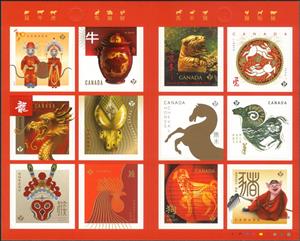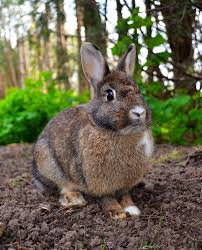Booklet: Year of the Ox 2021 : The Chinese Zodiac Cycle (Canada 2021)
Year of the Ox 2021 : The Chinese Zodiac Cycle (Canada 2021)
15 January (Canada ) within release Year of the Ox 2021 : The Chinese Zodiac Cycle goes into circulation Booklet Year of the Ox 2021 : The Chinese Zodiac Cycle face value 12*P No Face Value
| Booklet Year of the Ox 2021 : The Chinese Zodiac Cycle in catalogues | |
|---|---|
| Stamp Number: | Sn: CA 3272ai |
Booklet is square format.
Face value Ca$0.92 per stamp on day of issue. Unfolded booklet pane of 12 from Quarterly Pack.Also in the issue Year of the Ox 2021 : The Chinese Zodiac Cycle:
- Stamp - Dog Design from 2018 face value P;
- Stamp - Dog International Rate Design from 2018 face value P;
- Stamp - Dragon Design from 2012 face value P;
- Stamp - Dragon International Rate Design from 2012 face value P;
- Stamp - Horse Design from 2014 face value P;
- Stamp - Monkey Design from 2016 face value P;
- Stamp - Monkey International Rate Design from 2016 face value P;
- Stamp - Ox Design from 2009 face value P;
- Stamp - Ox International Rate Design from 2009 face value P;
- Stamp - Pig Design from 2019 face value P;
- Stamp - Pig International Rate Design from 2019 face value P;
- Stamp - Rabbit Design from 2011 face value P;
- Stamp - Rabbit International Rate Design from 2011 face value P;
- Stamp - Ram Design from 2015 face value P;
- Stamp - Ram International Rate Design from 2015 face value P;
- Stamp - Rat Design from 2020 face value P;
- Stamp - Rat International Rate Design from 2020 face value P;
- Stamp - Rooster Design from 2017 face value P;
- Stamp - Rooster International Rate Design from 2017 face value P;
- Stamp - Snake Design from 2013 face value P;
- Stamp - Snake International Rate Design from 2013 face value P;
- Stamp - Snake International Rate Design from 2014 face value P;
- Stamp - Tiger Design from 2010 face value P;
- Stamp - Tiger International Rate Design from 2010 face value P;
- Souvenir Sheet - Year of the Ox 2021 : The Chinese Zodiac Cycle face value 12*P;
- Booklet - Year of the Ox 2021 : The Chinese Zodiac Cycle face value 12*P;
- Booklet - Year of the Ox 2021 : The Chinese Zodiac Cycle face value 12*P;
- Booklet Pane - The Chinese Zodiac Cycle booklet pane face value 10*P;
Booklet Year of the Ox 2021 : The Chinese Zodiac Cycle it reflects the thematic directions:
Cattle (Bos taurus) are large, domesticated, bovid ungulates widely kept as livestock. They are prominent modern members of the subfamily Bovinae and the most widespread species of the genus Bos. Mature female cattle are called cows and mature male cattle are bulls. Young female cattle are called heifers, young male cattle are oxen or bullocks, and castrated male cattle are known as steers.
Chinese New Year or the Spring Festival (see also § Names) is a festival that celebrates the beginning of a new year on the traditional lunisolar Chinese calendar. Marking the end of winter and the beginning of spring, observances traditionally take place from Chinese New Year's Eve, the evening preceding the first day of the year, to the Lantern Festival, held on the 15th day of the year. The first day of Chinese New Year begins on the new moon that appears between 21 January and 20 February
The domestic dog (Canis lupus familiaris or Canis familiaris) is a member of genus Canis (canines) that forms part of the wolf-like canids, and is the most widely abundant carnivore. The dog and the extant gray wolf are sister taxa, with modern wolves not closely related to the wolves that were first domesticated. The dog was the first domesticated species and has been selectively bred over millennia for various behaviors, sensory capabilities, and physical attributes. Their long association with humans has led dogs to be uniquely attuned to human behavior and they are able to thrive on a starch-rich diet that would be inadequate for other canid species. Dogs vary widely in shape, size and colours. Dogs perform many roles for people, such as hunting, herding, pulling loads, protection, assisting police and military, companionship and, more recently, aiding handicapped individuals. This influence on human society has given them the sobriquet "man's best friend".
A dragon is a magical legendary creature that appears in the folklore of multiple cultures worldwide. Beliefs about dragons vary considerably through regions, but dragons in Western cultures since the High Middle Ages have often been depicted as winged, horned, and capable of breathing fire. Dragons in eastern cultures are usually depicted as wingless, four-legged, serpentine creatures with above-average intelligence. Commonalities between dragons' traits are often a hybridization of feline, reptilian, mammalian, and avian features. Some scholars believe large extinct or migrating crocodiles bear the closest resemblance, especially when encountered in forested or swampy areas, and are most likely the template of modern Asian dragon imagery
The horse (Equus ferus caballus) is one of two extant subspecies of Equus ferus. It is an odd-toed ungulate mammal belonging to the taxonomic family Equidae. The horse has evolved over the past 45 to 55 million years from a small multi-toed creature, Eohippus, into the large, single-toed animal of today. Humans began to domesticate horses around 4000 BC, and their domestication is believed to have been widespread by 3000 BC. Horses in the subspecies caballus are domesticated, although some domesticated populations live in the wild as feral horses. These feral populations are not true wild horses, as this term is used to describe horses that have never been domesticated, such as the endangered Przewalski's horse, a separate subspecies, and the only remaining true wild horse. There is an extensive, specialized vocabulary used to describe equine-related concepts, covering everything from anatomy to life stages, size, colors, markings, breeds, locomotion, and behavior.
Rabbits are small mammals in the family Leporidae (which also includes the hares), which is in the order Lagomorpha (which also includes pikas). The European rabbit, Oryctolagus cuniculus is the ancestor of the world's hundreds of breeds of domestic rabbit. Sylvilagus includes 13 wild rabbit species, among them the seven types of cottontail. The European rabbit, which has been introduced on every continent except Antarctica, is familiar throughout the world as a wild prey animal, a domesticated form of livestock and a pet. With its widespread effect on ecologies and cultures, in many areas of the world, the rabbit is a part of daily life – as food, clothing, a companion, and a source of artistic inspiration.
The tiger (Panthera tigris) is a member of the genus Panthera and the largest living cat species native to Asia. It has a powerful, muscular body with a large head and paws, a long tail and orange fur with black, mostly vertical stripes. It is traditionally classified into nine recent subspecies, though some recognise only two subspecies, mainland Asian tigers and the island tigers of the Sunda Islands.








